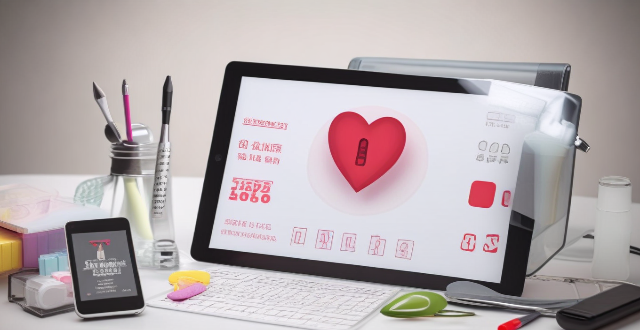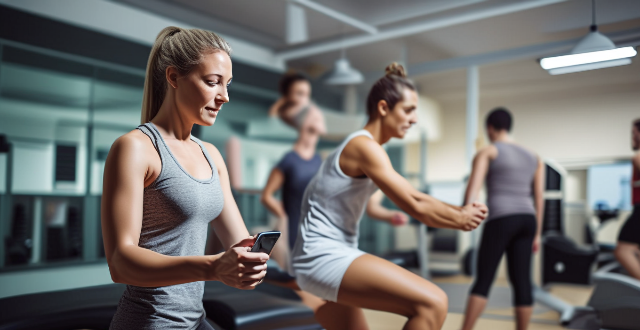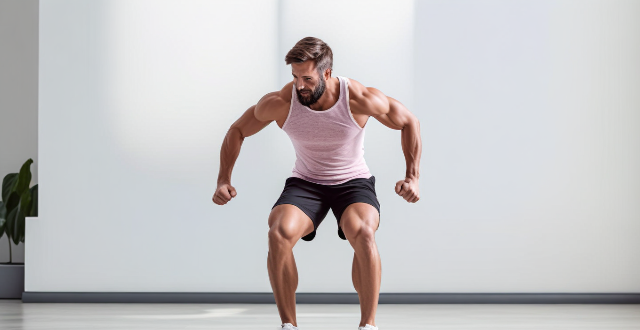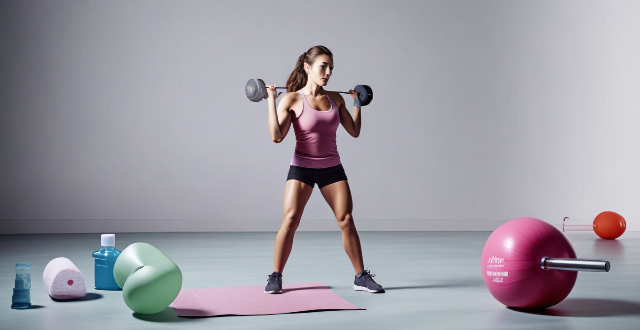Heart Workout

How can I use heart rate monitoring to improve my workout routine ?
Using a heart rate monitor can significantly improve your workout routine by providing valuable insights into your body's response to exercise. Here's how you can leverage heart rate monitoring to optimize your fitness regimen: - Understanding Heart Rate Zones: Your heart rate varies depending on the intensity of your workout. By understanding these heart rate zones, you can tailor your workouts to achieve specific goals, such as fat burning, endurance building, or performance improvement. - Setting Goals Based on Heart Rate: Establish clear objectives for each workout session based on your heart rate data, such as endurance training, weight loss, or performance enhancement. - Tracking Progress: Consistently monitor your heart rate during workouts to track progress, including recording resting heart rate and assessing recovery time. - Adjusting Intensity: Modify your workout intensity based on your heart rate feedback, such as increasing intensity if you're consistently below your target heart rate zone or decreasing intensity if you're above it. - Preventing Overtraining: Use heart rate data to avoid overtraining by staying within recommended heart rate limits and recognizing signs of overexertion. - Personalizing Your Workouts: Customize your routine with heart rate in mind by incorporating different training methods and experimenting with different activities to see which ones give you the desired heart rate response.

What are the benefits of monitoring heart rate during exercise ?
Monitoring your heart rate during exercise offers numerous benefits, including improved workout efficiency, better recovery, reduced risk of injury, increased motivation, and improved cardiovascular health. By keeping an eye on your heart rate, you can ensure you're getting the most out of every workout while also taking care of your body.

How often should I check my heart rate while exercising ?
Checking your heart rate is an important part of staying healthy and fit. However, how often you should check it depends on several factors, including your age, fitness level, and overall health. Here are some guidelines to help you determine the optimal frequency for checking your heart rate during exercise: For beginners: Check your heart rate every five minutes during the first few weeks of training to get a sense of your target heart rate range and adjust accordingly as you become more comfortable with the activity. For experienced athletes: Once or twice per workout is sufficient for experienced athletes who have established a good foundation in their fitness routine. This will allow them to focus more on their form and intensity without constantly worrying about their heart rate. For older adults or those with pre-existing health conditions: Older adults or those with pre-existing health conditions may need to monitor their heart rate more frequently than younger individuals. It's recommended that they check their heart rate at least once per workout and perhaps even before and after each session to stay safe and ensure they're not overexerting themselves.

Can heart rate monitoring help prevent overexertion during exercise ?
Overexertion during exercise can lead to fatigue, muscle soreness, and injuries. Heart rate monitoring is a technique used to measure the number of times a person's heart beats per minute (bpm). By monitoring your heart rate, you can determine personalized training zones based on age, fitness level, and goals, providing real-time feedback on current heart rate during exercise. Recovery time is essential for preventing overexertion, and heart rate monitoring helps determine how long it takes for the body to return to its resting state. Best practices for heart rate monitoring include choosing the right device, calibrating regularly, warming up properly, staying hydrated, and listening to your body. Following these guidelines and listening to your body can help prevent overexertion during exercise while maximizing its benefits.

How can I monitor my heart rate during exercise for optimal health results ?
Monitoring your heart rate during exercise is crucial for efficiency, safety, and progress tracking. Tools include heart rate monitors, smartphone apps, fitness trackers, and chest straps. Before starting, consult a doctor and choose the right tool. During exercise, wear your monitor, warm up, stay in your target heart rate zone, adjust intensity, and cool down. After exercise, record data, analyze results, and rest. Best practices include calibrating devices, staying hydrated, being consistent, and listening to your body.

What is the ideal heart rate for different types of exercises ?
When it comes to exercise, knowing your ideal heartWhen it comes to exercise, knowing your ideal heartimizing the benefits of your knowing your ideal heart rate is crucial for maximizing the benefits of your workout while minimizing the risk of injury. The recommended heart rate ranges vary depending on the type of exercise and your fitness level. For aerobic exercise, beginners should aim for 50-60% of their maximum heart rate (MHR), intermediate exercisers 60-70% of MHR, and advanced exercisers 70-85% of MHR. High-intensity interval training (HIIT) requires higher intensity, with beginners aiming for 70-80% of MHR, intermediate exercisers 80-90% of MHR, and advanced exercisers 90-100% of MHR. Resistance training also varies by fitness level, with beginners aiming for 50-60% of MHR, intermediate exercisers 60-70% of MHR, and advanced exercisers 70-85% of MHR. Yoga and Pilates are low-impact exercises that focus on flexibility, balance, and core strength, with beginners aiming for 40-50% of MHR, intermediate exercisers 50-60% of MHR, and advanced exercisers 60-70% of MHR. By monitoring your heart rate and staying within the recommended ranges, you can ensure that you're exercising safely and effectively.

Can you share some workout tips from famous celebrities ?
Here are some workout tips from famous celebrities: Dwayne "The Rock" Johnson emphasizes compound exercises and cardio. Serena Williams suggests mixing up your routine and staying active outside the gym. Jennifer Lopez incorporates dance into her workout and prioritizes recovery. Chris Hemsworth lifts heavy weights and incorporates HIIT. Find a workout routine that works for you and your individual goals and needs.

What are some common mistakes people make when monitoring their heart rate during exercise ?
When monitoring heart rate during exercise, common mistakes include incorrect sensor placement, over-reliance on technology, misinterpreting data, not tracking recovery time, and ignoring other factors. It's important to wear the sensor correctly, understand technology limitations, consider individual differences, track recovery time, and take environmental and medication factors into account for accurate readings.

How long should I wait before showering after an intense workout
After intense workout, wait 15-20 minutes before showering to cool down, reduce injury risk, rehydrate, and promote healthy skin.

In what ways can heart rate monitors improve athletic training ?
Heart rate monitors significantly enhance athletic training by enabling targeted intensity, objective data analysis, recovery monitoring, pacing strategies, and individualized training. To use them effectively, athletes should establish baseline measurements, set clear goals, create a structured plan, continuously monitor progress, and incorporate technology for easy tracking and insights.

Are there any risks associated with constantly monitoring heart rate during exercise ?
Monitoring heart rate during exercise is common but can pose risks like over-reliance on technology, psychological impacts, and physical risks. It's important to find a balance between using heart rate data and listening to your body's signals for a safe and enjoyable workout.

What is a good workout routine for beginners at the gym ?
This article provides a comprehensive guide for beginners on how to start a workout routine at the gym. It includes warm-up exercises, cardiovascular and strength training exercises, and cool down stretches. The article emphasizes the importance of starting slowly and gradually increasing the intensity of workouts. With dedication and consistency, beginners can achieve their fitness goals and improve their overall health and well-being.

What is the best way to monitor heart rate during exercise ?
Monitoring heart rate during exercise is crucial for staying healthy and achieving fitness goals. The best way to monitor heart rate during exercise depends on personal preferences and fitness goals. Wearable heart rate monitors are convenient and non-invasive, while chest straps provide accurate data. Fingertip devices are affordable and easy to use, but less accurate than other methods. Smartphone apps are free or inexpensive, but may not work well in certain situations. Ultimately, the choice between these methods should be based on individual needs and preferences.

What is the most effective workout routine for losing belly fat ?
The most effective workout routine for losing belly fat depends on individual factors such as age, fitness level, and overall health. Popular routines include HIIT (high-intensity interval training), strength training, and cardiovascular exercises. Tips for making these routines more effective include starting with a warm-up period, choosing enjoyable exercises that can be done for at least 30 seconds each, resting for 1-2 minutes between each burst of exercise or set of exercises, completing 3-4 sets of each exercise, and including at least one day of rest per week to allow muscles to recover.

Are sports nutrition supplements more effective when taken before or after a workout ?
The timing of when to take sports nutrition supplements can significantly impact their effectiveness. In this discussion, we will explore the benefits and drawbacks of taking sports nutrition supplements before and after a workout. Taking Supplements Before a Workout: Benefits include energy boost, muscle endurance, and hydration. Drawbacks include digestive discomfort, overstimulation, and timing issues. Taking Supplements After a Workout: Benefits include recovery support, reduced soreness, and hydration restoration. Drawbacks include delayed absorption, less effective for energy, and potential for overconsumption. In conclusion, the effectiveness of sports nutrition supplements depends largely on individual goals, preferences, and specific needs related to training intensity and duration. It is essential to consult with a healthcare professional or sports nutritionist to determine the best strategy for incorporating supplements into your fitness routine.

Can exercise reverse heart disease ?
Heart disease is a major cause of death worldwide, and it can be devastating to those affected. While there are many treatments available for heart disease, including medication and surgery, some people wonder if exercise can reverse the damage caused by heart disease. There is evidence that regular exercise can help prevent and manage heart disease by improving cardiovascular health, managing weight, lowering blood pressure, improving cholesterol levels, and reducing stress. However, there is no conclusive evidence that exercise can completely reverse heart disease. Despite this, there are still many benefits to regular exercise for heart health. If you have been diagnosed with heart disease or are at high risk for developing it, talk to your doctor about starting an exercise program. They can help you create an exercise plan that is safe and effective for your individual needs and goals.

What are the best workout routines for people with desk jobs ?
Incorporating regular exercise into your routine is essential for counteracting the negative effects of having a desk job, such as back pain, weight gain, and reduced cardiovascular fitness. The best workout routines for people with desk jobs include cardiovascular exercises like walking or jogging, cycling, and swimming; strength training exercises such as bodyweight exercises, resistance bands, and dumbbells or kettlebells; and stretching and mobility exercises like yoga or Pilates, foam rolling, and dynamic stretching. By making exercise a part of your routine, you'll not only counteract the negative effects of sitting but also boost your energy levels and productivity throughout the day.

Can stretching after a workout improve flexibility ?
Stretching after a workout can improve flexibility, reduce muscle soreness, and aid in recovery. To stretch properly, hold each stretch for at least 30 seconds, avoid bouncing, and focus on major muscle groups.

How does age affect heart rate during exercise ?
Age affects heart rate during exercise by altering the structure and function of the aging heart, reducing maximum heart rate, shifting autonomic regulation towards sympathetic dominance, and decreasing cardiac reserve. Older individuals can still improve their cardiovascular fitness through regular exercise and lifestyle modifications.

What are the benefits of post-workout stretching ?
The article discusses the benefits of post-workout stretching, including improved flexibility, reduced muscle soreness, increased circulation, and injury prevention. It emphasizes that stretching after a workout is an essential part of any fitness routine and can lead to better overall health.

What are the best workout routines for women ?
The article provides a list of the best workout routines for women, including cardiovascular exercises like running, cycling, and swimming; strength training exercises like weight lifting, resistance bands, and bodyweight exercises; yoga and Pilates; high-intensity interval training (HIIT) like Tabata, circuit training, and jump rope; group fitness classes like Zumba, kickboxing, and barre; outdoor workouts like hiking, rock climbing, and stair climbing; and low-impact workouts like walking, elliptical machine, and rowing machine. These workouts can help women improve their overall fitness, strength, flexibility, balance, and cardiovascular health.

Can physical activity reduce the risk of heart disease ?
Regular physical activity can significantly reduce the risk of heart disease by improving blood circulation, strengthening heart muscles, and reducing major risk factors such as high blood pressure, high cholesterol, and diabetes. Recommended types of exercise include aerobic activities and strength training. Following guidelines from health organizations like the WHO can help maintain cardiovascular health.

How accurate are fitness trackers in monitoring heart rate ?
The accuracy of fitness trackers in monitoring heart rate can be affected by various factors, including device quality, skin type and color, movement, and environmental factors. To improve the accuracy of your fitness tracker's heart rate monitor, it is recommended to choose a reputable brand with advanced sensors and algorithms, wear your device correctly, calibrate your device, and use multiple sensors or a chest strap for better results. By following these tips, you can make more informed decisions about your health and fitness goals.

What are the best post-workout recovery techniques
The text discusses the importance of post-workout recovery for achieving optimal physical performance and preventing injuries. The author recommends several techniques including stretching, hydration, protein intake, foam rolling, massage therapy, active recovery, and sleep. Stretching improves flexibility and reduces muscle soreness, while hydration replaces lost fluids during exercise. Protein intake helps repair and rebuild muscles, foam rolling relieves muscle tension, massage therapy reduces inflammation, active recovery promotes circulation, and sleep allows the body to repair and rebuild itself. Incorporating these techniques into a routine can help improve performance and prevent injuries.

Is it better to stretch before or after a workout ?
Stretching is an essential component of any exercise routine. It helps to improve flexibility, reduce the risk of injury, and enhance overall performance. However, there has been a long-standing debate about whether it is better to stretch before or after a workout. In this article, we will explore both sides of the argument and provide our recommendations based on current research. Stretching Before a Workout: Advantages include warm-up for muscles and potential injury prevention. Disadvantages may include reduced strength and overstretching. Stretching After a Workout: Advantages include improved flexibility and aiding in recovery. Disadvantages may include delayed onset muscle soreness (DOMS). Recommendations: Based on current research, both pre- and post-workout stretching have their benefits and drawbacks. Perform dynamic stretches before exercise to warm up your muscles without compromising strength or power output. Incorporate static stretches after your workout to improve flexibility and aid in recovery. Make stretching a regular part of your exercise routine for consistent improvements in flexibility and overall performance.

How can I prevent muscle soreness after a workout
Stretching, warm-up, hydration, nutrition, rest, massage, ice therapy, and avoiding overtraining are all important steps to help prevent muscle soreness after a workout.

How does stretching help with recovery after a workout ?
Stretching is crucial for recovery after a workout. It improves blood circulation, reduces muscle soreness and stiffness, enhances flexibility, promotes better range of motion, prevents injury, and reduces stress. Incorporating stretching into your post-workout routine can greatly enhance your recovery process.

What are some tips for staying motivated during a gym workout ?
Staying motivated during a gym workout can be challenging, but crucial for maintaining a consistent exercise routine. Tips include setting clear goals, creating an energetic playlist, finding a workout buddy, mixing up your routine, tracking progress, rewarding yourself, visualizing success, embracing challenges, getting adequate rest, and focusing on how exercise makes you feel. By implementing these strategies, you can make the most out of your gym workouts and stay consistent in your fitness journey.

How long should I hold each stretch after a workout ?
Stretching after a workout is crucial for reducing muscle soreness, improving flexibility, and preventing injuries. The recommended duration for each stretch varies depending on the type of stretching: - Static stretching: Hold each stretch for 15-30 seconds and repeat 2-4 times. - Dynamic stretching: Perform 8-12 repetitions per stretch and 1-2 sets. To make the most out of your post-workout stretching routine, focus on breathing, avoid bouncing, listen to your body, and be consistent.